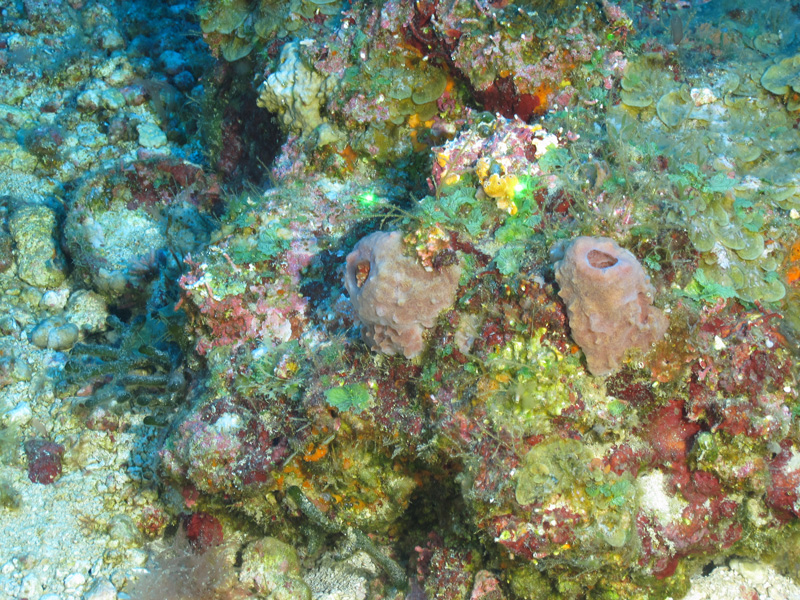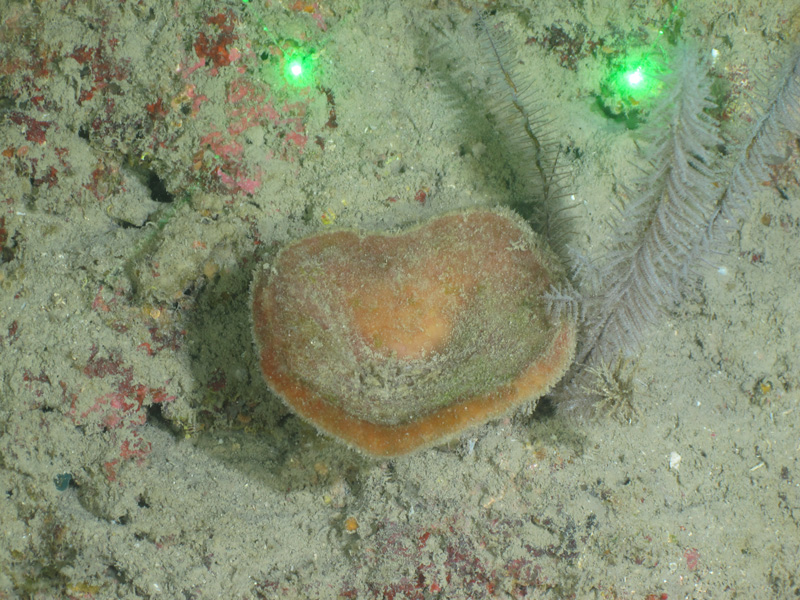What Are Sponges and Why Do They Matter?
Sponges are ancient animals that may appear simplistic, but the more we study them, the more we realize how complex they are. They are bizarre and beautiful – nothing like the yellow, plastic rectangle next to your kitchen sink. Sponges create important habitat for other animals, and some even contain chemicals that may help researchers design future medicines.

This “corndog sponge” (Rhizaxinella clava) was collected during an Exploring the Blue Economy Biotechnology Potential of Deepwater Habitats expedition dive on Bright Bank at a depth of 120 meters (394 feet). Image courtesy of Exploring the Blue Economy Biotechnology Potential of Deepwater Habitats. Download larger version (jpg, 5.16 MB).
Sponges are very different from other animals. They are immobile, stuck to whatever surface they grow on. They have no nervous system to send messages within their bodies, no digestive system to process food, and no circulatory system to pump blood. A sponge instead gets everything it needs from ocean currents, which deliver food and oxygen as water flows through the sponge’s body. It’s a simple strategy, but it works: Sponges have been around for hundreds of millions of years and have evolved into a stunning range of forms.

This orange sponge Agelas clathrodes was spotted alongside the anemone Condylactis gigantea during an Exploring the Blue Economy Biotechnology Potential of Deepwater Habitats expedition dive at a depth of 50 meters (164 feet) on Bright Bank. The sponge provides habitat for reef fish and produces known natural products. Image courtesy of Exploring the Blue Economy Biotechnology Potential of Deepwater Habitats. Download larger version (jpg, 6.15 MB).
They can be soft as dough, hard like stone, or delicate as glass. Some are dull colors, while others can be beautiful oranges, yellows, purples, or blues. They come in every shape imaginable. Reef-building sponges form enormous barrels, elegant vases, massive boulders, twisting branches, and clusters of tubes like a church organ. Other sponges bore into rocks and corals, and some form a crust over underwater objects, like living wallpaper.

Sponges like these Xestospongia sp. individuals were encountered commonly on the Exploring the Blue Economy Biotechnology Potential of Deep Water Habitats expedition. Image courtesy of Exploring the Blue Economy Biotechnology Potential of Deepwater Habitats. Download larger version (jpg, 6.86 MB).

This unidentified orange encrusting sponge was collected during an Exploring the Blue Economy Biotechnology Potential of Deepwater Habitats expedition dive at a depth of 65 meters (213 feet) at Bright Bank, a site that was rich in sponges. Image courtesy of Exploring the Blue Economy Biotechnology Potential of Deepwater Habitats. Download larger version (jpg, 6.27 MB).
Sponges help create habitat, filter particles from seawater, contribute to carbon, nitrogen, and silica cycling. They have also been used for bathing since ancient Egypt. But most importantly for research expeditions such as the Exploring the Blue Economy Biotechnology Potential of Deepwater Habitats expedition, many sponges produce medically important chemicals called marine natural products, which can be used to treat human diseases. By collecting specimens, researchers can study these sponges and the compounds they produce in order to better understand these unique animals and to advance medical science for future generations.

Plate sponges in the family Corallistidae were common near the Flower Garden Banks and were collected for further analysis on the Exploring the Blue Economy Biotechnology Potential of Deepwater Habitats expedition. Certain species in this family are known to produce pharmaceutically relevant compounds. Image courtesy of Exploring the Blue Economy Biotechnology Potential of Deepwater Habitats. Download larger version (jpg, 4.59 MB).

Previous research has found that the purple sponge Aiolochroia crassa produces natural products that are of interest for biomedical science. This specimen was sampled near Bright Bank at 60 meters (197 meters) depth during the Exploring the Blue Economy Biotechnology Potential of Deepwater Habitats expedition. Image courtesy of Exploring the Blue Economy Biotechnology Potential of Deepwater Habitats. Download larger version (jpg, 4.41 MB).
By Elizabeth Urban-Gedamke and Shirley Pomponi, Florida Atlantic University - Harbor Branch Oceanographic Institute
Published May 9, 2022
Last updated August 21, 2024
Relevant Expedition: Exploring the Blue Economy Biotechnology Potential of Deepwater Habitats